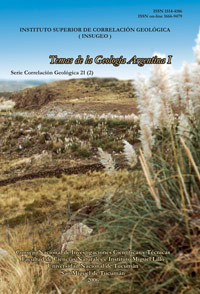Serie Correlación Geológica 21 (2)
Regiones Sismotectónicas en el centro-oeste argentino. Provincias de La Rioja, San Juan y Mendoza.
Descargar trabajo en formato PDFResumen
REGIONES SISMOTECTÓNICAS EN EL CENTRO-OESTE ARGENTINO. PROVINCIAS DE LA RIOJA, SAN JUAN Y MENDOZA. Existe una relación estrecha entre las grandes estructuras definidas en este trabajo y la localización de los eventos sísmicos superficiales, especialmente en lo referente a la separación de ambientes con diferentes niveles de actividad sísmica. Estas grandes estructuras aparentemente también delimitarían alguno de los ambientes volcánicos, especialmente neógenos y las diferentes áreas con actividad tectónica neógena. Interpretando estos lineamientos como bordes o límites transicionales entre regiones corticales que muestran diferentes aspectos morfoestructurales, se determinaron cuatro regiones sismotectónicas, en las que el comportamiento de los esfuerzos durante el presente marco tectónico, se puede interpretar como característico de esa región. A partir de patrones regionales que rigen los grandes rasgos morfoestructurales, se determinaron cuatro regiones sismotectónicas. El número y los límites de tales áreas podría modificarse en el futuro, a medida que se obtenga mayor información sobre la distribución de la sismicidad, vulcanismo y del fallamiento activo en cada una de ellas.
Abstract
REGIONES SISMOTECTÓNICAS EN EL CENTRO-OESTE ARGENTINO. PROVINCIAS DE LA RIOJA, SAN JUAN Y MENDOZA. There is a close relationship between the greater structures as defined in this paper, and the localization of seismic events, specially regarding the separation of environments with different seismic activity levels. Apparently, these greater structures would also bound some of the volcanic settings, mainly Neogene in age, and the different areas with Neogene tectonic activity. Understanding these alignments like borders or transitional limits among cortical regions that show different morphostructural aspects, three seismotectonic regions were determined, in which the behavior of the efforts during the present tectonic régime can be interpreted as characteristic of that region. The number and the limits of these areas could be changed in the future, as more information on the distribution of seismicity, volcanism and of the active faulting in each one of them is obtained.






